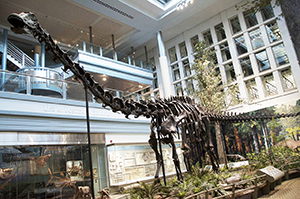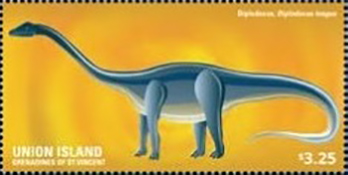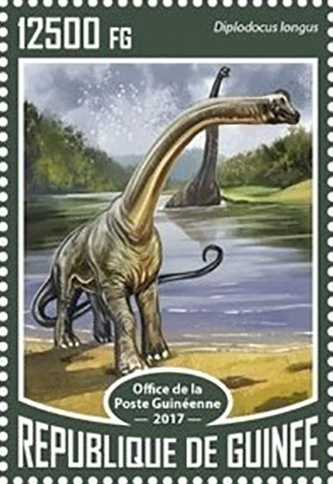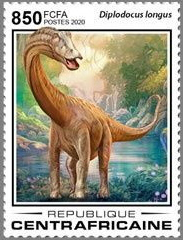Diplodocus longus Marsh, 1878

(Da: en.wikipedia.org)
Phylum: Chordata Haeckel, 1874
Subphylum: Vertebrata Cuvier, 1812
Classe: Dinosauria Owen, 1841
Ordine: Saurischia Seeley, 1887
Famiglia: Diplodocidae Marsh, 1884
Genere: Diplodocus Marsh, 1878
Descrizione
Era l'originale specie tipo, nota soprattutto per due vertebre caudali frammentarie, rinvenute nella Formazione Morrison, in Colorado. Anche se alcuni esemplari più completi sono stati attribuiti a tale specie, un'analisi più dettagliata ha decretato che il fossile originale non ha abbastanza caratteristiche distintive per essere classificato come specie a se stante. Per questo motivo, oggi D. longus è considerato un nomen dubium. Oggi, una petizione alla Commissione internazionale per la nomenclatura zoologica, sta lavorando per rendere D. carnegii la nuova specie tipo.
Diffusione
Visse in quello che oggi è il Nord America occidentale, alla fine del periodo Giurassico.
Bibliografia
–Ulrich Merkl (November 25, 2015). Dinomania: The Lost Art of Winsor McCay, The Secret Origins of King Kong, and the Urge to Destroy New York. Fantagraphics Books. ISBN 978-1-60699-840-3.
–Breithaupt, Brent H, The discovery and loss of the “colossal” Brontosaurus giganteus from the fossil fields of Wyoming (USA) and the events that led to the discovery of Diplodocus carnegii: the first mounted dinosaur on the Iberian Peninsula, VI Jornadas Internacionales sobre Paleontología de Dinosaurios y su Entorno, 5-7 September 2013, p.49.
–Simpson, John; Edmund Weiner, eds. (1989). The Oxford English Dictionary (2nd ed.). Oxford: Oxford University Press. ISBN 978-0-19-861186-8.
–Pickett, Joseph P., ed. (2000). The American Heritage Dictionary of the English Language (4th ed.). Boston: Houghton Mifflin Company. ISBN 978-0-395-82517-4.
–Tschopp, E.; Mateus, O. V.; Benson, R. B. J. (2015). "A specimen-level phylogenetic analysis and taxonomic revision of Diplodocidae (Dinosauria, Sauropoda)". PeerJ. 3: e857.
–Turner, C.E.; Peterson, F. (2004). "Reconstruction of the Upper Jurassic Morrison Formation extinct ecosystem—a synthesis". Sedimentary Geology. 167 (3-4): 309-355.
–Lambert D. (1993). The Ultimate Dinosaur Book. DK Publishing. ISBN 978-0-86438-417-1.
–Paul, Gregory S. (2016). Princeton Field Guide to Dinosaurs. Princeton University Press. ISBN 978-0-691-13720-9.
–Foster, J.R. (2003). Paleoecological Analysis of the Vertebrate Fauna of the Morrison Formation (Upper Jurassic), Rocky Mountain Region, U.S.A. New Mexico Museum of Natural History and Science:Albuquerque, New Mexico. Bulletin 23.
–Benson, R. B. J.; Campione, N. S. E.; Carrano, M. T.; Mannion, P. D.; Sullivan, C.; Upchurch, P.; Evans, D. C. (2014). "Rates of Dinosaur Body Mass Evolution Indicate 170 Million Years of Sustained Ecological Innovation on the Avian Stem Lineage". PLOS Biology. 12 (5): e1001853.
–Holtz, Thomas R., Jr.; Rey, Luis V. (2011). Dinosaurs: the most complete, up-to-date encyclopedia for dinosaur lovers of all ages (Winter 2011 appendix). New York: Random House. ISBN 978-0-375-82419-7.
–Gillette, D.D., 1994, Seismosaurus: The Earth Shaker. New York, Columbia University Press, 205 pp.
–Carpenter, K. (2006). "Biggest of the big: a critical re-evaluation of the mega-sauropod Amphicoelias fragillimus." In Foster, J.R. and Lucas, S.G., eds., 2006, Paleontology and Geology of the Upper Jurassic Morrison Formation. New Mexico Museum of Natural History and Science Bulletin 36: 131-138.
–Herne, Matthew C.; Lucas, Spencer G. (2006). "Seismosaurus hallorum: Osteological reconstruction from the holotype". New Mexico Museum of Natural History and Science Bulletin. 36.
–"The biggest of the big". Skeletaldrawing.com. June 14, 2013.
–Wedel, M.J. and Cifelli, R.L. Sauroposeidon: Oklahoma's Native Giant. 2005. Oklahoma Geology Notes 65: 2.
–Wilson JA (2005). "Overview of Sauropod Phylogeny and Evolution". In Rogers KA, Wilson JA (eds.). The Sauropods:Evolution and Paleobiology. Indiana University Press. pp. 15-49. ISBN 978-0-520-24623-2.
–Holland WJ (1915). "Heads and Tails: a few notes relating to the structure of sauropod dinosaurs". Annals of the Carnegie Museum. 9: 273-278.
–Myhrvold NP, Currie PJ (1997). "Supersonic sauropods? Tail dynamics in the diplodocids". Paleobiology. 23 (4): 393-409.

|
Data: 14/10/2014
Emissione: Dinosauri Stato: Union Island |
|---|

|
Data: 09/10/2017
Emissione: Animali preistorici Stato: Guinea Nota: Emesso in un foglietto di 4 v. diversi |
|---|

|
Data: 24/07/2020
Emissione: I dinosauri Stato: Central African Republic |
|---|